2005 SUBARU FORESTER clutch
[x] Cancel search: clutchPage 266 of 477

7-9
Starting and operating
– CONTINUED –
Preparing to drive
You should perform the following checks and adjust-
ments every day before you start driving.
1. Check that all windows, mirrors, and lights are
clean and unobstructed.
2. Check the appearance and condition of the tires.
Also check tires for proper inflation.
3. Look under the vehicle for any sign of leaks.
4. Check that the hood and rear gate are fully closed.
5. Check the adjustment of the seat.
6. Check the adjustment of the inside and outside mir-
rors.
7. Fasten your seatbelt. Check that your passengers
have fastened their seatbelts.
8. Check the operation of the warning and indicator
lights when the ignition switch is turned to the “ON” po-sition.
9. Check the gauges, indicator and warning lights af-
ter starting the engine.
NOTE
Engine oil, engine coolant, brake fluid, washer flu-
id and other fluid levels should be checked daily,
weekly or at fuel stops.
Starting the engine
Do not operate the starter motor continuously
for more than ten seconds. If the engine fails to
start after operating the starter for five to ten
seconds, wait for ten seconds or more before
trying again.
�„ Manual transmission vehicle
1. Apply the parking brake.
2. Turn off unnecessary lights and accessories.
3. Press the clutch pedal to the floor and shift the shift
lever into neutral. Hold the clutch pedal to the floor
while starting the engine.
The starter motor will only operate when the clutch
pedal is pressed fully to the floor.
4. Turn the ignition switch to the “ON” position and
check the operation of the warning and indicator lights.
Refer to the “Warning and indicator lights” section(chapter 3).
5. Turn the ignition switch to the “START” position
without depressing the accelerator pedal. Release
the key immediately after the engine has started.
Page 269 of 477
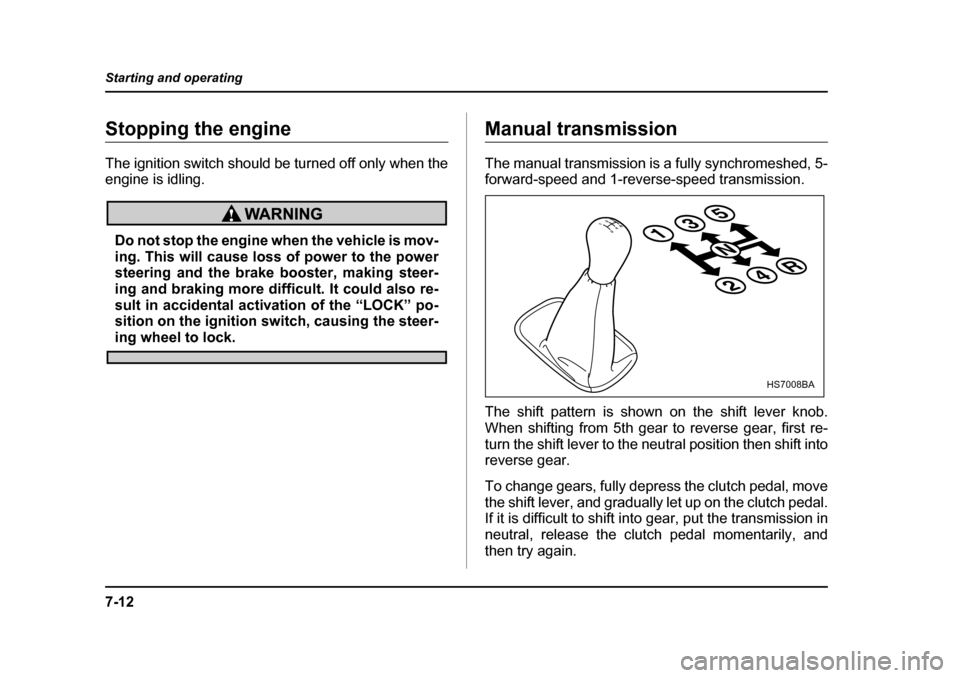
7-12
Starting and operating
Stopping the engine
The ignition switch should be turned off only when the
engine is idling.
Do not stop the engine when the vehicle is mov-
ing. This will cause loss of power to the power
steering and the brake booster, making steer-
ing and braking more difficult. It could also re-
sult in accidental activation of the “LOCK” po-
sition on the ignition switch, causing the steer-
ing wheel to lock.
Manual transmission
The manual transmission is a fully synchromeshed, 5-
forward-speed and 1-reverse-speed transmission.
The shift pattern is shown on the shift lever knob.
When shifting from 5th gear to reverse gear, first re-
turn the shift lever to the neutral position then shift into
reverse gear.
To change gears, fully depress the clutch pedal, move
the shift lever, and gradually let up on the clutch pedal.
If it is difficult to shift into gear, put the transmission in
neutral, release the clutch pedal momentarily, and
then try again.
135
24R
N
13524R
HS7008BA
Page 270 of 477
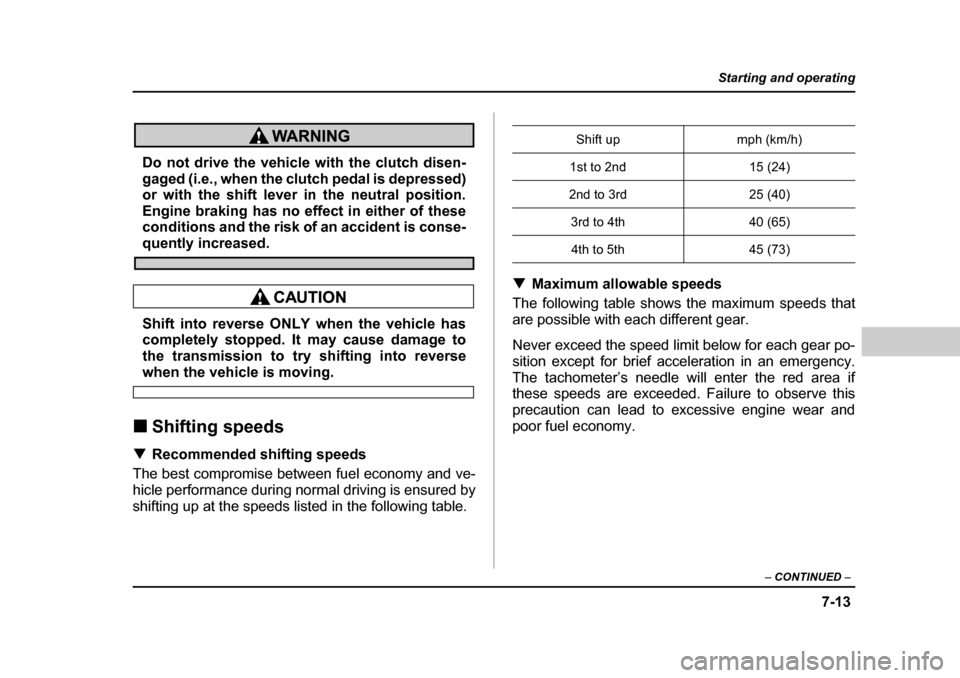
7-13
Starting and operating
– CONTINUED –
Do not drive the vehicle with the clutch disen-
gaged (i.e., when the clutch pedal is depressed)
or with the shift lever in the neutral position.
Engine braking has no effect in either of these
conditions and the risk of an accident is conse-
quently increased.
Shift into reverse ONLY when the vehicle has
completely stopped. It may cause damage to
the transmission to try shifting into reverse
when the vehicle is moving.
�„ Shifting speeds
�T Recommended shifting speeds
The best compromise between fuel economy and ve-
hicle performance during normal driving is ensured by
shifting up at the speeds listed in the following table. �T
Maximum allowable speeds
The following table shows the maximum speeds that
are possible with each different gear.
Never exceed the speed limit below for each gear po-
sition except for brief acceleration in an emergency.
The tachometer’s needle will enter the red area if
these speeds are exceeded. Failure to observe this
precaution can lead to excessive engine wear and
poor fuel economy. Shift up mph (km/h)
1st to 2nd 15 (24)
2nd to 3rd 25 (40)
3rd to 4th 40 (65)4th to 5th 45 (73)
Page 271 of 477

7-14
Starting and operating
mph (km/h)
When shifting down a gear, ensure that the ve-
hicle is not traveling at a speed exceeding the
Maximum Allowable Speed for the gear which
is about to be selected. Failure to observe this
precaution can lead to engine over-revving and
this in turn can result in engine damage.
In addition, sudden application of engine
brakes when the vehicle is travelling on a slip-
pery surface can lead to wheel locking; as a
consequence, control of the vehicle may be lost
and the risk of an accident increased.
�„ Driving tips
Do not drive with your foot resting on the clutch pedal and do not use the clutch to hold your vehicle at a
standstill on an upgrade. Either of those actions may
cause clutch damage.
Do not drive with your hand resting on the shift lever.
This may cause wear on the transmission compo-
nents.
When it is necessary to reduce vehicle speed due to
slow traffic, turning corners, or driving up steep hills,
downshift to a lower gear before the engine starts to
labor.
On steep downgrades, downshift the transmission to
4th, 3rd or 2nd gear as necessary; this helps to main-
tain a safe speed and to extend brake pad life.
In this way, the engine provides a braking effect. Re-
member, if you “ride” (over use) the brakes while de-
scending a hill, they may overheat and not work prop-
erly.
Non-turbo
models Turbo
models
1st 30 (49) 28 (46)
2nd 51 (82) 52 (83)
3rd 73 (117) 73 (118)
Page 293 of 477
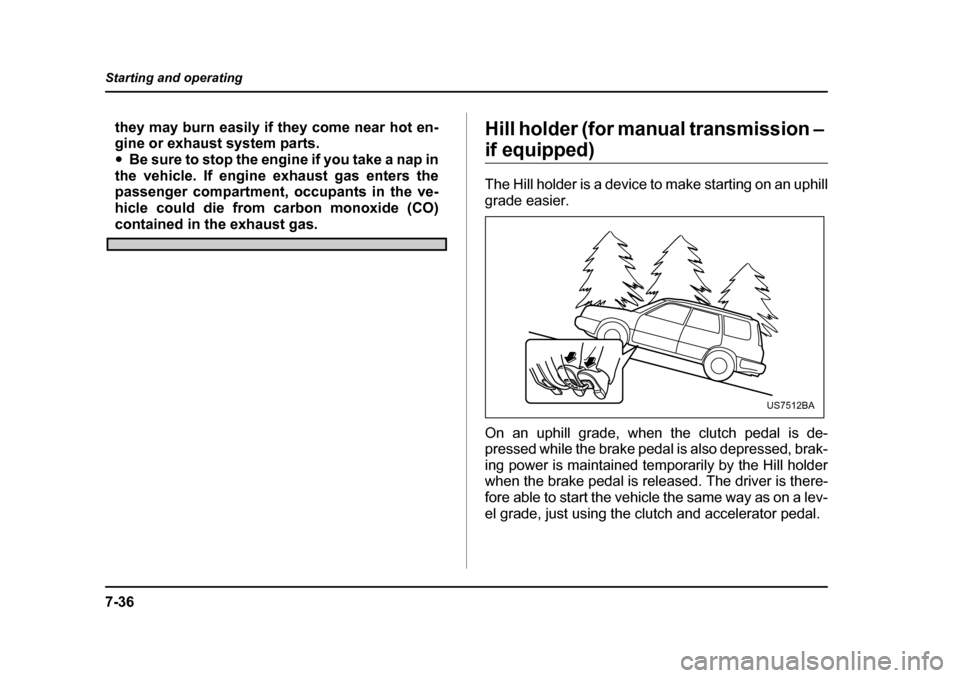
7-36
Starting and operating
they may burn easily if they come near hot en-
gine or exhaust system parts.�y
Be sure to stop the engine if you take a nap in
the vehicle. If engine exhaust gas enters the
passenger compartment, occupants in the ve-
hicle could die from carbon monoxide (CO)
contained in the exhaust gas. Hill holder (for manual transmission –
if equipped)
The Hill holder is a device to make starting on an uphill
grade easier.
On an uphill grade, when the clutch pedal is de-
pressed while the brake pedal is also depressed, brak-
ing power is maintained temporarily by the Hill holder
when the brake pedal is released. The driver is there-
fore able to start the vehicle the same way as on a lev-
el grade, just using the clutch and accelerator pedal.
US7512BA
Page 294 of 477
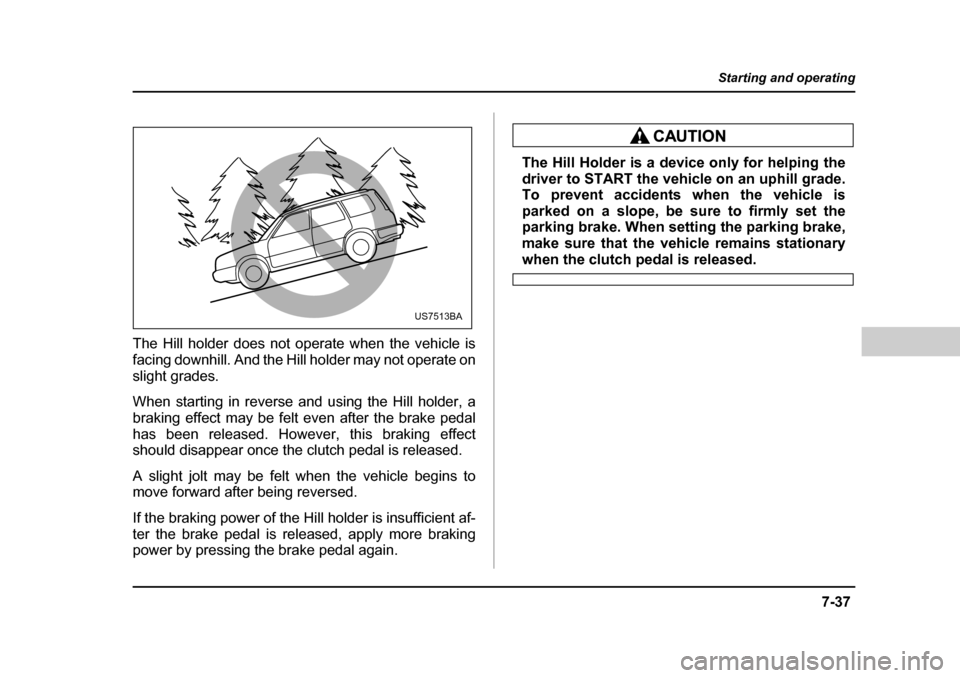
7-37
Starting and operating
– CONTINUED –
The Hill holder does not operate when the vehicle is
facing downhill. And the Hill holder may not operate on
slight grades.
When starting in reverse and using the Hill holder, a
braking effect may be felt even after the brake pedal
has been released. However, this braking effect
should disappear once the clutch pedal is released.
A slight jolt may be felt when the vehicle begins to
move forward after being reversed.
If the braking power of the Hill holder is insufficient af-
ter the brake pedal is released, apply more braking
power by pressing the brake pedal again.
The Hill Holder is a device only for helping the
driver to START the vehicle on an uphill grade.
To prevent accidents when the vehicle is
parked on a slope, be sure to firmly set the
parking brake. When setting the parking brake,
make sure that the vehicle remains stationary
when the clutch pedal is released.
US7513BA
Page 297 of 477
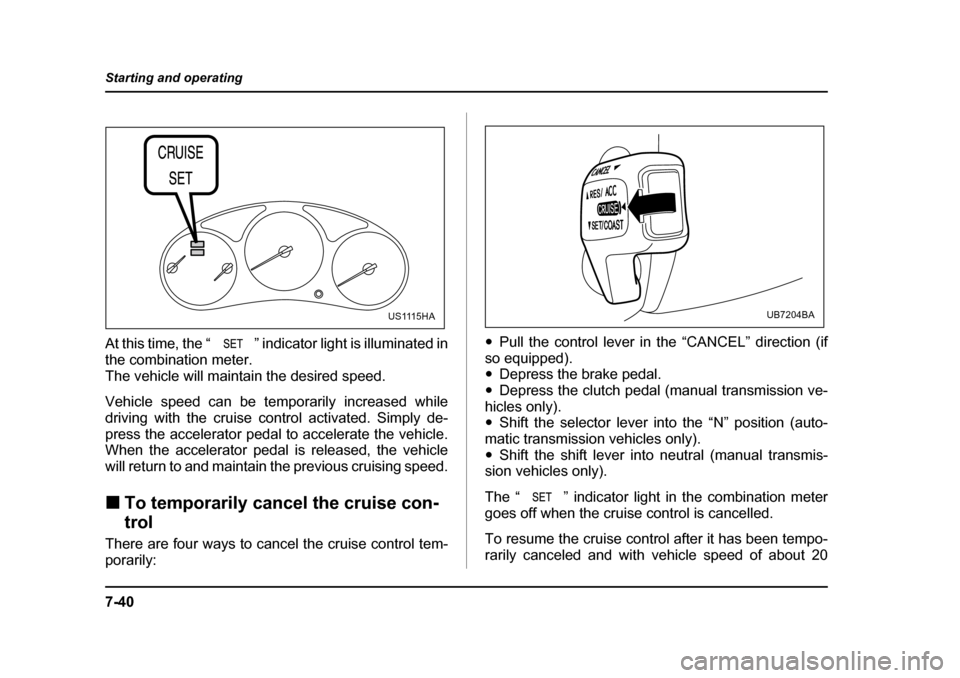
7-40
Starting and operating
At this time, the “ ” indicator light is illuminated in
the combination meter.
The vehicle will maintain the desired speed.
Vehicle speed can be temporarily increased while
driving with the cruise control activated. Simply de-
press the accelerator pedal to accelerate the vehicle.
When the accelerator pedal is released, the vehicle
will return to and maintain the previous cruising speed. �„
To temporarily cancel the cruise con- trol
There are four ways to cancel the cruise control tem-
porarily: �y
Pull the control lever in the “CANCEL” direction (if
so equipped). �y Depress the brake pedal.
�y Depress the clutch pedal (manual transmission ve-
hicles only).�y Shift the selector lever into the “N” position (auto-
matic transmission vehicles only). �y Shift the shift lever into neutral (manual transmis-
sion vehicles only).
The “ ” indicator light in the combination meter
goes off when the cruise control is cancelled.
To resume the cruise control after it has been tempo-
rarily canceled and with vehicle speed of about 20
US1115HAUB7204BA
Page 335 of 477
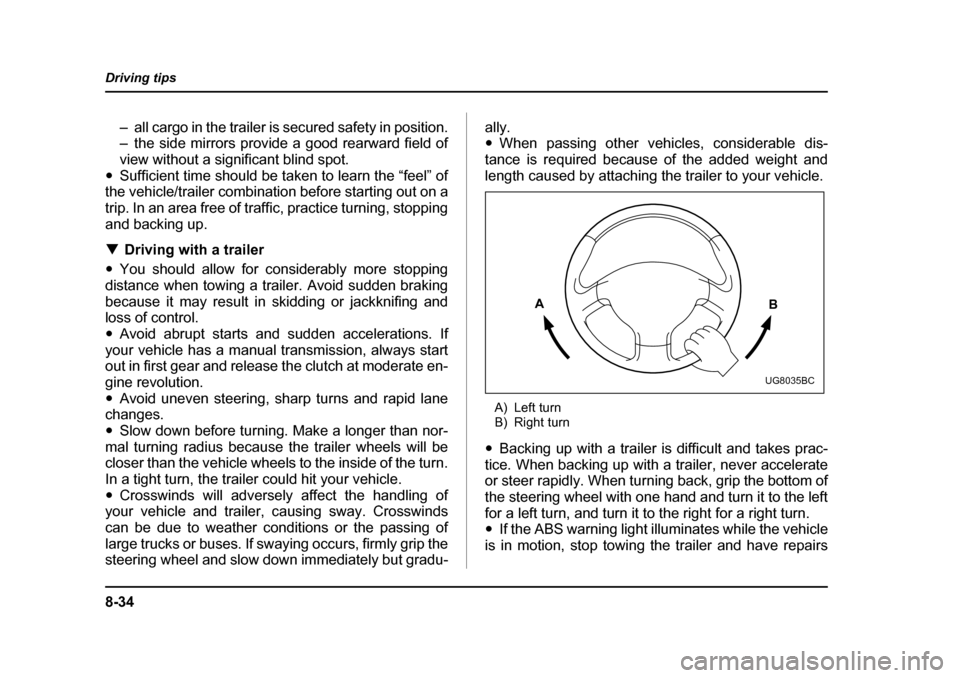
8-34
Driving tips
– all cargo in the trailer is secured safety in position.
– the side mirrors provide a good rearward field of
view without a significant blind spot.
�y Sufficient time should be taken to learn the “feel” of
the vehicle/trailer combination before starting out on a
trip. In an area free of traffic, practice turning, stopping
and backing up. �T Driving with a trailer
�y You should allow for considerably more stopping
distance when towing a trailer. Avoid sudden braking
because it may result in skidding or jackknifing and
loss of control.�y Avoid abrupt starts and sudden accelerations. If
your vehicle has a manual transmission, always start
out in first gear and release the clutch at moderate en-
gine revolution. �y Avoid uneven steering, sharp turns and rapid lane
changes. �y Slow down before turning. Make a longer than nor-
mal turning radius because the trailer wheels will be
closer than the vehicle wheels to the inside of the turn.
In a tight turn, the trailer could hit your vehicle. �y Crosswinds will adversely affect the handling of
your vehicle and trailer, causing sway. Crosswinds
can be due to weather conditions or the passing of
large trucks or buses. If swaying occurs, firmly grip the
steering wheel and slow down immediately but gradu- ally.�y
When passing other vehicles, considerable dis-
tance is required because of the added weight and
length caused by attaching the trailer to your vehicle.
A) Left turn
B) Right turn
�y Backing up with a trailer is difficult and takes prac-
tice. When backing up with a trailer, never accelerate
or steer rapidly. When turning back, grip the bottom of
the steering wheel with one hand and turn it to the left
for a left turn, and turn it to the right for a right turn. �y If the ABS warning light illuminates while the vehicle
is in motion, stop towing the trailer and have repairs
A B
UG8035BC